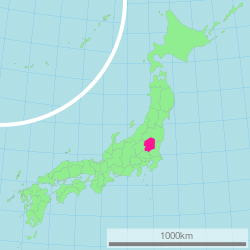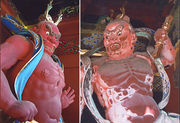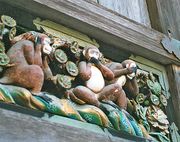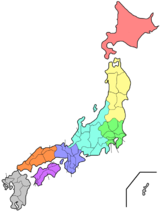Tochigi Prefecture
| Tochigi Prefecture | |||||||||
|
|||||||||
 |
|||||||||
| Capital | Utsunomiya | ||||||||
| Region | Kantō | ||||||||
| Island | Honshū | ||||||||
| Governor | Tomikazu Fukuda | ||||||||
| Area (rank) | 6,408.28 km² (20th) | ||||||||
| - % water | 0.2% | ||||||||
| Population (January 1, 2003) | |||||||||
| - Population | 2,011,313 (20th) | ||||||||
| - Density | 314 /km² | ||||||||
| Districts | 6 | ||||||||
| Municipalities | 31 | ||||||||
| ISO 3166-2 | JP-09 | ||||||||
| Website | English web site | ||||||||
| Prefectural symbols | |||||||||
| - Flower | Yashio tsutsuji (Rhododendron albrechtii) |
||||||||
| - Tree | Japanese horse chestnut (Aesculus turbinata) |
||||||||
| - Bird | Blue-and-white Flycatcher (Cyanoptila cyanomelana) |
||||||||
| - Fish | |||||||||
Symbol of Tochigi Prefecture |
|||||||||
| Template ■ Discussion ■ WikiProject Japan | |||||||||
Tochigi Prefecture (栃木県 Tochigi-ken) is a prefecture located in the Kantō region on the island of Honshū, Japan. The capital is the city of Utsunomiya. Utsunomiya is famous for its many gyoza specialist shops. Also located in Utsunomiya, Tochigi Prefecture has one of the largest shopping malls in the North Kantō region, Bell Mall.
Nikkō, whose ancient Shinto shrines and Buddhist temples UNESCO has recognized by naming them a World Heritage Site, is in this prefecture. [1] Nikkō is approximately one hour by train from Tokyo and approximately 35 km west of the capital Utsunomiya.
Other famous parts of Tochigi include a region called Nasu known for onsen and local sake and ski resorts. The Imperial family has a villa in Nasu. Nasu-Shiobara is a major Shinkansen station.
Another onsen resort is at Kinugawa Onsen.
Contents |
Prefectural overview
Situated among the inland prefectures of the northern part of the Kanto region, Tochigi is contiguous with Ibaraki, Gunma, Saitama, and Fukushima prefecture.
The climate of Tochigi may be classified as a humid temperate zone with broad variations in temperature. Winters are arid with dry winds, while summers are humid with frequent thunderstorms.
The population of Tochigi as of March 2007 was approximately 2,014,900. The population increased until 2005, but started to decrease in 2006, as the population of Japan decreased, too. About 500,000 people live in the prefectural capital of Utsunomiya, with the remainder dispersed over 14 other cities and 17 towns.
Located in the center of the prefecture is the largest open plain in the Kanto region. Shirane (2,578 m), Nantai (2,484 m) and Nasudake (1,917 m) mountain are in the northern part of the area. Kinugawa, Nakagawa, and Watarase River originate in this region, which flow across the Kanto plain before emptying into the Pacific Ocean. Tochigi is the 20th largest prefecture in Japan with a total area of 6,408 square km.
History
In the late 7th century, Tochigi formed Shimotsuke Province. During that time was built the Shimotsuke-Yakushi temple, making it the Buddhist capital of the Kanto Region.
In the early 15th century, Ashikaga University, Japan's oldest school of higher education, was re-established, holding over 3000 students by the 16th century. Saint Francis Xavier introduced Ashikaga to the world as the best university in Japan.
In the early 17th century, Japan was unified by the Shogun Tokugawa Ieyasu. After his death, Toshogu was built in Nikko on what the shoguns thought of as holy ground to protect and worship Ieyasu. The establishment of the Nikkō Toshogu in 1617 brought Nikkō to national attention. The Tokugawa Shogunate developed the Nikkō Kaidō (日光街道, part of the major road connecting Nikkō with Edo) and required lavish processions to worship Ieyasu, the founder of the Tokugawa line of shoguns.
In the late 19th century the Tokugawa Shogunate fell and the new government established the prefectures. The prefectural capital was established in the city of Tochigi after the unification of Utsunomiya Prefecture and Tochigi Prefecture in 1873. By 1884, however, the capital was transferred to Utsunomiya.
Municipalities

Cities
Fourteen cities are located in Tochigi Prefecture.
|
|
|
Towns
These are the towns in each district:
|
|
|
Mergers
Industry and agriculture
Located close to Tokyo, Tochigi is home to many corporations and industrial zones, including the Kiyohara Industrial Complex, one of the largest inland industrial complexes in the country.
Industrial manufacturing accounts for 36.6% of the prefecture's total output. Vehicle parts and accessories are the primary products, followed by vehicles, radios and televisions, pharmaceuticals, and wireless communication equipment.
Below are goods manufactured in Tochigi with the highest market share in Japan:
| Product | Share |
|---|---|
| Camera lenses | 71.3% |
| X-ray equipment for medical use | 54.5% |
| Machinery and appliances for dental use | 23.5% |
| X-ray equipment parts | 57.5% |
| Injection molded plastic parts | 14.1% |
(The 2004 industrial analysis report published by the Ministry of Economy, Trade and Industry)
The annual gross agricultural output in Tochigi is about 274 billion yen. Rice, vegetables, and livestock are produced in the region. Tochigi is also known for strawberries, Chinese chives, and Japanese pears sold throughout Japan and exported to other countries. Approximately 55% of Tochigi is covered by forests. Mushrooms, such as Shiitake mushrooms, make up half of the forest industry, with an output of approximately 5.6 billion yen.
Education
Tochigi is home to many universities and colleges including those for science and technology, literature, medicine, education, and art. Below is a list of some of the universities located in Tochigi:
- Utsunomiya University
- Ashikaga Institute of Technology
- International University of Health and Welfare, Otawara
- Sakushin Gakuin University, Utsunomiya
- Jichi Medical School, Shimotsuke
- Teikyo University, Utsunomiya
- Dokkyo University School of Medicine, Mibu
- Utsunomiya Kyowa University, Utsunomiya and Nasushiobara
- Hakuoh University, Oyama
- Bunsei University of Art, Utsunomiya
- Oyama National College of Technology
- Tochigi College of Industry and Technology (Central), Utsunomiya
- Tochigi College of Industry and Technology (North), Nasu
- Tochigi College of Industry and Technology (South), Ashikaga
People
Sports
The sports teams listed below are based in Tochigi.
Football (soccer)
- Tochigi S.C. (Utsunomiya)
Ice Hockey
- Nikkō Ice Bucks (Nikkō)
Basketball
Motorsport
- Twin Ring Motegi circuit
Tourism
Nikkō National Park is famous for its UNESCO World Heritage Site which was registered as the 10th World Heritage Site in 1999. This encompasses Rinnō-ji, Nikkō Tōshō-gū, Mount Nantai, and Futarasan Shrine. The Kegon Falls, also in Nikkō, is popular with tourists. To travel between the city and the falls, automobiles and buses take the Irohazaka, a road with dozens of switchbacks. In addition, 400 year-old Japanese Cedars (about 13,000 in total) line the famous Cedar Avenue of Nikkō for roughly 35 km, making it the longest tree-lined avenue in the world.[2]


Japan's oldest university, Ashikaga University, as well as traditional towns such as the city of Tochigi are also part of the prefecture's rich heritage.
A more recent and modern attraction is the Twin Ring Motegi Circuit race course, which hosts the only IndyCar race outside the United States. The track also hosts many other race events including Formula One and motorcycle races as well as festivals and fireworks events.
Tochigi has many traditional festivals and events such as Nikkō Tōshō-gū's 1000 Samurai Procession and Horseback Archery Festival, and the city of Tochigi's Autumn Festival where doll floats are pulled around the city once every five years.
Other attractions include
- Nikkō Tōshō-gū
- Rinnō-ji
- Futarasan Shrine
- Kegon Falls
- Lake Chuzenji
- Kirifuri Falls
- Mashiko
- Shiobara Hot Spring
- Nasu resort area
- Kinugawa Hot Spring
- Twin Ring Motegi (motorsports complex)
Transportation and access
Roadways
Traversing the prefecture along the north-south axis and connecting to the rest of the country are the Tōhoku Expressway and the new and old Route 4. From east to west spans Rout 50, connecting southern Tochigi with Ibaraki and Gunma Prefectures.
Also connecting Tochigi, Gunma, and Ibaraki is the Kita-Kantō Expressway, with the 18.5 km that connect the Tochigi-Tsuga Interchange and the Utsunomiya-Kaminokawa Interchange. Portions of the Kita-Kantō Expressway are still being constructed and is set to be fully completed by 2011. The highway will link the region's other main transport arteries, the Tōhoku, the Jōban and the Kan-Etsu Expressways, providing a link to the international port of Hitachinaka in Ibaraki.
Railways
The Tohoku Shinkansen and the JR Utsunomiya Line are the main railways running north and south in Tochigi. Shinkansen runs from Tokyo Station to Oyama in south Tochigi in 43 minutes. Utsunomiya can be reached by rail in as little as 48 minutes, and many parts of Tochigi are within commuting range of central Tokyo. To the east and west, the Mito and Ryōmō Lines connect Tochigi to Ibaraki and Gunma.
Freight is served by the Utsunomiya Freight Terminal.
- East Japan Railway Company
- Tōhoku Shinkansen
- Shōnan-Shinjuku Line
- Utsunomiya Line (Tōhoku Main Line)
- Nikkō Line
- Ryōmō Line
- Mito Line
- Karasuyama Line
Air travel
Within approximately an hour's drive along the Tohoku Expressway from Utsunomiya is Fukushima Airport. International and national air transportation is through Narita International Airport to the east of Tokyo and approximately three hours by vehicle from Utsunomiya.
See also
- Ashikaga murder case
References
- ↑ http://whc.unesco.org/archive/repcom99.htm#913
- ↑ Gardening World Records. Retrieved on 2 November 2008.
External links
 Media related to Tochigi prefecture at Wikimedia Commons
Media related to Tochigi prefecture at Wikimedia Commons- Official Tochigi Prefecture website
- Tochigi International Association website
- Bell Mall Website Japanese
- Tochigi travel guide from Wikitravel
|
|||
| Cities | |||
|---|---|---|---|
| Ashikaga | Kanuma | Mooka | Nasukarasuyama | Nasushiobara | Nikkō | Ōtawara | Oyama | Sakura | Sano | Shimotsuke | Tochigi | Utsunomiya (capital) | Yaita | |||
| Districts | |||
| Haga | Kamitsuga | Kawachi | Nasu | Shimotsuga | Shioya | |||
|
|
|||||||||||||||||||||||||||||||||
